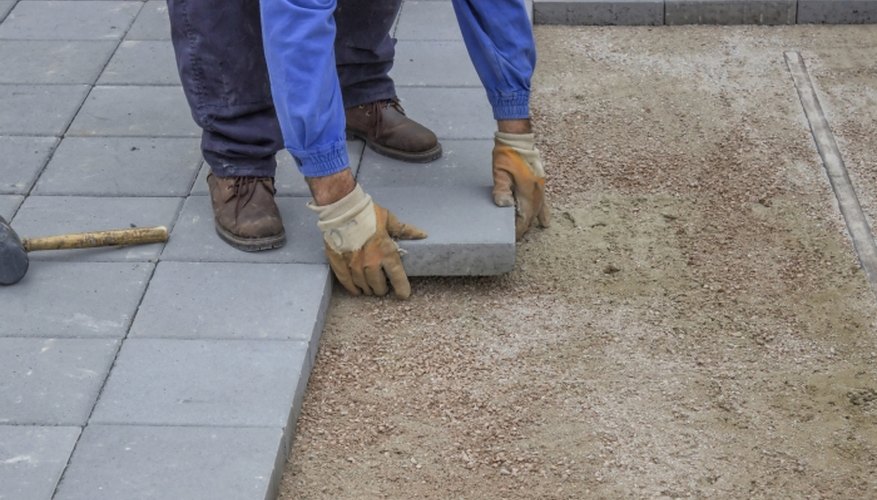Paving slabs, often made of natural stone, concrete or brick, provide decorative supports for patios, decks, walks and driveways. Most of these installations don't require excessive preparation, such as pouring concrete, but rather sit within the soil of your landscape. You can't just set the slabs on top of your grass, however; you have to excavate and prepare the area to ensure the paving pieces sit flat and remain stable against weathering and shifting.
Create a guide for your project by outlining the perimeter of your installation area with marking paint.
- Paving slabs, often made of natural stone, concrete or brick, provide decorative supports for patios, decks, walks and driveways.
- Create a guide for your project by outlining the perimeter of your installation area with marking paint.
Dig out your installation area to a depth of 18 cm (7 inches). This should get you down to undisturbed subsoil, which provides a better support for your paving slab than the worked soil on top.
Remove any stones or sticks from the soil you have exposed. Run a plate compactor over the entire area to flatten the surface completely. You must start with a stable, flat base to achieve a stable, flat installation.
Pour a 10-cm (4-inch) layer of paver base or crushed stone evenly over the installation area. Smooth out the stones with a garden rake, and then compact the surface with the plate compactor to flatten out the area.
Top the paver base with a 25 mm (1 inch) layer of sand. Moisten the sand with a hose so that it is easier to spread, and create a completely flat layer on top of the base. Compact this surface as well; this will be the final surface on which you set your slabs.
Set your paving slabs on top of the sand in your designated design. Tap each slab against the previous slab you installed and then drop it into place to avoid dragging it through the sand and disrupting your flat surface.
- Pour a 10-cm (4-inch) layer of paver base or crushed stone evenly over the installation area.
- Tap each slab against the previous slab you installed and then drop it into place to avoid dragging it through the sand and disrupting your flat surface.
Cut slabs with a diamond blade wet saw as necessary to fit in your design. This saw is specifically designed to cut through stone and brick.
Lay all full and cut slabs until your project is complete. Surround the area with plastic or metal edging material to help prevent shifting. These kits come with stakes that will hold the edge in place against the slabs. Drive them in at a slight angle toward the slabs for best hold.
Spread a layer of sand on top of the slabs and force it into the joints with a broom. Moisten the sand to help it settle. When all joints are filled, sweep away the excess sand and compact the entire surface, working first horizontally across the surface (like mowing a lawn) and then at 90 degrees to ensure that everything is settled.
- Cut slabs with a diamond blade wet saw as necessary to fit in your design.
- Spread a layer of sand on top of the slabs and force it into the joints with a broom.
TIP
You can lay the slabs directly onto the soil, but it is likely they will shift and drainage will run slowly. The paver base and sand help to ensure the stability of your installation. Some installers recommend that you cover excavated soil with a layer of landscape fabric. Consider this extra step, especially if you have traditionally experienced rainwater drainage problems. The fabric will help water to drain without shifting the subsoil. Get in touch with local building code officials and utility providers before starting your paving project. These professionals will inform you of any requirements or restrictions on your project and will also make sure that you do not damage any underground wires or lines as you dig.
WARNING
This project requires safety equipment to avoid injury. Wear ear protection when you run the plate compactor. Add protective goggles, gloves and a dust mask when using the saw to cut through paving slabs.
